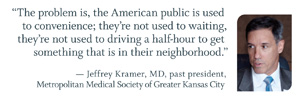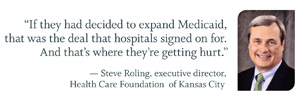Health Care KC: How Good? …And for How Long?
The record shows that Kansas City is blessed with a multitude of top-tier hospitals. But will that record hold up when federal health reforms kick in next year?

The numbers come with increasing frequency, and increasing scope:
April 30: Mercy health system in Springfield announces staff reductions of 100 positions, including layoffs, through consolidation of its hospital and physician clinic business offices.
May 15: Liberty Hospital says it will reduce its work force by 129 positions, with nurses among those laid off.
May 21: Wichita-based Via Christi Health says it will lay off up to 400 members of its staff across Kansas.
David Feess, CEO at Liberty Hospital, called the layoff decision one of the hardest he’s been involved with nearly 25 years there. But he knows what’s happening at his organization is not occurring in a vacuum. “I think all health-care organizations are having to adapt to the current environment and a changing environment, and asking themselves how do you focus on quality care but still be efficient in its delivery,” Feess said. “That’s what we’re trying to focus in on.”
Quality health care—perhaps even disproportionately high levels of it—have long been a selling point for recruiting businesses and employees to the KC region. Every large metro area makes the same boast, but in Kansas City’s case, it’s easy to see the depth and breadth of that medical excellence. A deep dive into the records of the Joint Commission, a national organization that accredits more than 20,000 health-care organizations and programs nationwide, provides a better look at just how good the care here is.
While the commission’s Gold Seal of Approval recognizes superior hospital performance in dozens of categories and sub-categories, six levels of care offer a broad look at the level of respect achieved by area hospitals. In the fields of stroke treatment, cancer treatment, cardiac care, surgical procedures, general medicine and women’s health, 35 of the largest hospitals and medical centers in the region yield a grid nearly filled with Gold Seal recognition handed down in recent years. And more than a fourth of those organizations achieved Gold Seal ratings in all six categories.
That’s a lot of good health care. The question is, in the face of additional hospital cuts in staffing and programming, will it be more than the region can afford in the new medical paradigm that comes with full implementation of federal health-care reforms next year? And would reductions in staffing and programming mean less access to health care that is simply nearby—or a genuine reduction in access to it?
One example of the difference in practice: HCA Midwest’s recent acquisition of St. Mary’s Medical Center in Blue Springs inspired a community dread that the hospital might not remain open, given the presence of HCA’s Centerpoint Medical Center six miles away—even though both offer comparable levels of service. A lot of rural communities would love to have health-care access problems like that.
“That’s exactly right,” says Jeffrey Kramer, a cardiothoracic surgeon at the University of Kansas Hospital. “The problem is, the American public is used to convenience; they’re not used to waiting, they’re not used to driving a half-hour to get something that is in their neighborhood.”
Kansas City as a region, he said, has nearly a dozen open-heart surgery programs. “In a lot of developed nations,” said Kramer, a past president of the Metropolitan Medical Society, “there are very few countries that have 10 or 11 open-heart programs—countries.”
In that sense, we’ve been living beyond our medical means, he says. “Expectations have to change,” he said. “The system can’t afford to have convenience and non-medical issues enter into the decision-making process.”
His successor with Metro Med, John Gianino, sees what’s going on with hospital decision-making as a premature reaction to a problem that remains ill-defined.
“The issue with ACA and the implementation of health-care reform is that we don’t really know what is going to happen over the next few years,” he said. “I think what we’re seeing with some of the cutbacks that hospitals are having to go through is just a sign of that insecurity. Whether it impacts quality of care or not is really hard to say—in some respects, it may actually help quality.”
That’s an argument previously advanced by chief executives Bob Page of KU Hospital and Mark Laney at Heartland Health in St. Joseph, two of the largest hospitals in the region, and other administrators. As a region, the Kansas City area is over-bedded with its hospitals—and by extension, overbooked with programs that can fill those beds.
“If it does what it says it’s supposed to do, ACA will improve the efficiency of the overall system,” Gianino said. “That in and of itself should make the quality of health care better. If we can provide at least the same level of quality, if not higher quality, with less cost, then obviously we’re increasing the value of health care to the citizens of our region.”
And yet, discussions about the financial impacts of ACA overlook the elephant in the operating room, says Rick Kahle, president of the employee benefits division for Lockton Companies. Surveys by the American Medical Association and others have gauged a clear sense that many physicians—especially those with short horizons to retirement—will give up their practices rather than fight the reduced reimbursment levels and other compliance demands of ACA.
“The lack of primary-care and primary care physicians is huge,” Kahle said. “That system is already stressed today, and if you add millions of new people to that system, at a time where more primary-care physicians are looking to get out than get in,
access to primary care becomes a real challenge.”
Problems with ACA implementation could become particularly acute in this region, says Steve Roling of the Health Care Foundation of Greater Kansas City, because of the politics involved in the issue at the state level. Neither Kansas nor Missouri was willing to sign on with creation of the on-line exchanges that are proposed as portals to coverage for hundreds of thousands of people in the two-state region.
To follow his point, it’s impor-tant to know that in the past, urban hospitals have received a disproportionate share of what are known as “dish” payments—for the Disproportionate Share Hospital programs that provide federal reimbursements to help cover the costs of indigent care.
“When hospitals signed on as endorsers, one of the deals with ACA was, you give up part of your dish payments, we’ll increase Medicaid payments 133 percent,” Roling said. “If get more Medicaid money because of raising the current rate, it’s fair to lose dish payments.”

But because neither state has agreed to expand its Medicaid program, Roling said, hospitals are going to be caught in a squeeze when that DSH funding is cut. “If they had decided to expand Medicaid,” Roling said, “that was the deal that hospitals signed on for. And that’s where they’re getting hurt.”
That, however, is just one cost factor Liberty Hospital’s Feess cited when assessing the looming fiscal peril. “There are a multitude of changes,” he said. “Federal sequestration, the Medicaid expansions not occurring, the Medicare program funding changing.” On top of that, the commercial insurance market is changing in anticipation of ACA’s impacts, as well. Because of that, he said, “each organization will have to focus on how best to prepare for these changes.”
At his hospital, that meant discontinuation of the wound-care and patient transportation programs—popular with those who used them, but lacking the volume to pay their administrative costs. That’s the kind of decision-making that is going on in hospital conference rooms throughout the area, he said.
“I do believe there will be some consolidation, but if you’re going to offer a service or product in health care, you should certainly strive to offer the best you possibly can,” Feess said. “The long-term issue becomes the economics. The transportation program was a great community service, but one we eliminated. A lot of people utilized it, but we have to make decisions. Those are the tough decisions each organization has to grapple with, given the services they offer the community and the community need.”
Perhaps the saving grace of ACA is the way that business, which provides health-care insurance for 159 million Americans through employer-paid programs, is responding. More and more, employers are engaging their work forces in programs to stop smoking, and some are even offering incentives for employees who lose weight or otherwise reduce health-risk factors. They’re also improving food selections in vending machines, sponsoring fitness challenges and finding other innovative ways to engage employees to raise fitness levels.
That focus, said Steve Best, human resources director for J.E. Dunn Construction Co., should take precedence over discussions about the impact of ACA or health-insurance rates.
“In a way,” he said, “I’m in the healthcare business.” But he said we’re spending a lot of time talking about health insurance and not enough time talking about health status, wellness, well-being and productivity in general. “Healthy employees are happier employees and more productive employees,” so we need to shift the converstaion back to health status, Best said.
Kramer concurred. “If ACA does what it’s supposed to in terms of optimizing prevention and good primary care so you treat this chronic condition without it getting to a crisis point because there’s no health insurance, that is a good thing,” he said. “But I don’t think you’re going to see primary-care people start taking care of complex problems.”
Even something like heart failure, he said, requires a level of treatment far more complicated than was the case just a decade ago. “There are all kinds of new things on the horizon that primary-care people not attuned to.” Kramer said. “People do want less cost, but they also want high quality. And you have to pay for quality to some extent.”